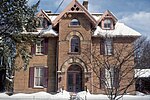Newburgh, New York

Newburgh is a city in Orange County, New York, United States. With a population of 28,856 as of the 2020 census, it is a principal city of the Poughkeepsie–Newburgh–Middletown metropolitan area. Located 60 miles (97 km) north of New York City, and 90 miles (140 km) south of Albany on the Hudson River within the Hudson Valley Area, the city of Newburgh is located near Stewart International Airport, one of the primary airports for Downstate New York. The Newburgh area was first settled in the early 18th century by the Germans and British. During the American Revolution, Newburgh served as the headquarters of the Continental Army. Prior to its chartering in 1865, the city of Newburgh was part of the town of Newburgh; the town now borders the city to the north and west. East of the city is the Hudson River; the city of Beacon is across the river and it is connected to Newburgh via the Newburgh–Beacon Bridge. The entire southern boundary of the city is with the town of New Windsor. Most of this boundary is formed by Quassaick Creek. In May 2016, the city requested help for its PFOS contaminated water supply under Superfund.Newburgh is the location of numerous preserved landmarks, including Washington's Headquarters, the David Crawford House, New York State Armory, the Dutch Reformed Church, and Newburgh Colored Burial Ground. George Washington and Franklin Delano Roosevelt had ties to the city; Ulysses S. Grant, Robert Kennedy, and Theodore Roosevelt also visited, the latter delivering a famous speech at a nearby shipyard. The city served as a planning ground for the Gothic Revival architectural movement in America, headed by native Andrew Jackson Downing with English architects Calvert Vaux and Frederick Clarke Withers. Mount Saint Mary College is a private liberal arts college located here.
Excerpt from the Wikipedia article Newburgh, New York (License: CC BY-SA 3.0, Authors, Images).Newburgh, New York
I 84;NY 52, Town of Newburgh
Geographical coordinates (GPS) Address Nearby Places Show on map
Geographical coordinates (GPS)
| Latitude | Longitude |
|---|---|
| N 41.519722222222 ° | E -74.021388888889 ° |
Address
I 84;NY 52
12550 Town of Newburgh
New York, United States
Open on Google Maps










